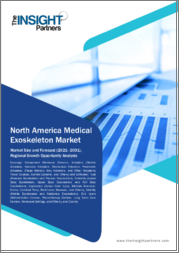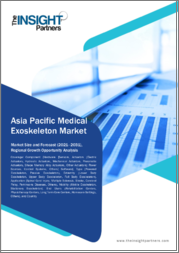
|
시장보고서
상품코드
1472125
세계의 의료용 외골격 시장 규모 조사 및 예측 : 유형별, 이동성별, 구성요소별, 용도별, 지역별 분석(2023-2030년)Global Medical Exoskeleton Market Size Study & Forecast, by Type, by Mobility, by Component, by Application and Regional Analysis, 2023-2030 |
||||||
세계 의료용 외골격 시장은 2022년 약 3억 달러로 평가되며, 2023-2030년 예측 기간 동안 29.40% 이상의 건강한 성장률로 성장할 것으로 예상됩니다.
의료용 외골격은 착용자의 신체 능력을 보조, 강화 및 재활을 위해 설계된 착용형 로봇 장치입니다. 이 장치는 일반적으로 의료 현장에서 운동 장애, 신경 장애, 근골격계 손상을 가진 사람들을 돕기 위해 사용됩니다. 또한 의료용 외골격은 마비 및 운동 장애가있는 사람들이 일어나고, 걷고, 일상 활동을 수행하는 데 도움이됩니다. 의료용 외골격은 사용자의 팔다리를 지원하고 근력과 협응력을 향상시킵니다. 또한, 신경 질환의 유병률 증가, 척수 손상 및 뇌 손상 수 증가, 노인 인구 증가, 외골격 기술 개발을 위한 기업과 연구 기관 간의 합의 및 공동 개발 증가는 2023-2030년 예측 기간 동안 시장에 유리한 수요를 창출할 것으로 예상됩니다.
뇌졸중, 척수 손상, 다발성 경화증, 파킨슨병과 같은 신경 질환은 이동과 자립을 심각하게 제한할 수 있습니다. 의료용 외골격은 이러한 질환을 앓고 있는 사람들에게 도움과 지원을 제공하여 운동 능력을 되찾고 일상 활동을 독립적으로 수행할 수 있도록 하는 솔루션을 제공합니다. 파킨슨 재단에 따르면 전 세계적으로 1,000만 명 이상이 파킨슨병(PD)을 앓고 있으며, 매년 6만 명의 미국인이 파킨슨병 진단을 받고 있습니다. 또한 세계보건기구(WHO)에 따르면 신경질환은 전 세계 질병 부담의 6.3%를 차지합니다. 이에 따라 혁신적이고 효과적인 치료법에 대한 수요가 증가하고 있으며, 이는 의료용 외골격의 성장을 주도하고 있습니다. 또한, 시장 기업들의 제품 승인 증가와 의료비 증가는 시장에 유리한 기회를 창출할 것으로 예상됩니다. 그러나 의료용 외골격의 승인을 확보하기 위한 규제 문제와 높은 장비 비용으로 인해 2023-2030년 예측 기간 동안 시장 성장을 저해하고 있습니다.
의료용 외골격 세계 시장 조사에서 고려된 주요 지역은 아시아태평양, 북미, 유럽, 라틴아메리카, 중동 및 아프리카 등입니다. 북미는 로봇 공학, 재료 과학, 인공지능의 급속한 발전, 우호적인 규제 환경, 주요 시장 기업의 존재로 인해 2022년 시장을 장악했습니다. 반면, 아시아태평양은 신경 질환 발병률 증가, 고령화 인구 증가, 정부의 통합된 이니셔티브 및 자금 지원 등의 요인으로 인해 예측 기간 동안 가장 빠른 성장률을 보일 것으로 예상됩니다.
이 조사의 목적은 최근 몇 년 동안 다양한 부문과 국가의 시장 규모를 파악하고 향후 몇 년 동안의 시장 규모를 예측하는 것입니다. 이 보고서는 조사 대상 국가의 산업의 질적, 양적 측면을 모두 포함하도록 설계되었습니다.
또한, 향후 시장 성장을 규정하는 촉진요인과 도전 과제 등 중요한 측면에 대한 자세한 정보도 제공합니다. 또한, 주요 기업들의 경쟁 상황과 제품 제공에 대한 상세한 분석과 함께 이해관계자들이 투자할 수 있는 미시적 시장에서의 잠재적 기회도 포함하고 있습니다.
목차
제1장 주요 요약
제2장 세계의 의료용 외골격 시장 정의와 범위
- 조사 목적
- 시장 정의와 범위
- 산업의 진화
- 조사 범위
- 조사 대상 연도
- 통화 환산율
제3장 의료용 외골격 세계 시장 역학
- 의료용 외골격 시장의 영향 분석(2020-2030년)
- 시장 성장 촉진요인
- 신경질환 유병률 증가
- 척수 손상과 뇌손상 증가
- 노인 인구 증가
- 시장 과제
- 의료용 외골격 승인 확보를 위한 규제상 과제
- 높은 기기 비용
- 시장 기회
- 시장 진출 기업에 의한 제품 승인 증가
- 헬스케어 지출 증가
- 시장 성장 촉진요인
제4장 세계의 의료용 외골격 시장 산업 분석
- Porter's Five Forces 모델
- 공급 기업의 교섭력
- 구매자의 교섭력
- 신규 참여업체의 위협
- 대체품의 위협
- 경쟁 기업 간의 경쟁 관계
- Porter's Five Forces 영향 분석
- PEST 분석
- 정치
- 경제
- 사회
- 기술
- 환경
- 법률
- 주요 투자 기회
- 주요 성공 전략
- COVID-19 영향 분석
- 파괴적 동향
- 업계 전문가의 관점
- 애널리스트의 결론과 제안
제5장 의료용 외골격 세계 시장 : 유형별
- 시장 현황
- 의료용 외골격 세계 시장 : 유형별, 실적 - 잠재성 분석
- 의료용 외골격 세계 시장 : 유형별 추정과 예측, 2020-2030년
- 의료용 외골격 세계 시장, 하위 부문별 분석
- 동력식 외골격
- 패시브 외골격
제6장 의료용 외골격 세계 시장, 모빌리티별
- 시장 현황
- 의료용 외골격 세계 시장 : 모빌리티별, 실적 - 잠재성 분석
- 의료용 외골격 세계 시장 : 모빌리티별 추정과 예측, 2020-2030년
- 의료용 외골격 세계 시장, 하위 부문별 분석
- 고정형
- 이동식
제7장 의료용 외골격 세계 시장 : 컴포넌트별
- 시장 현황
- 의료용 외골격 세계 시장 : 컴포넌트별, 실적 - 잠재성 분석
- 의료용 외골격 세계 시장, 컴포넌트별 추정과 예측, 2020-2030년
- 의료용 외골격 세계 시장, 하위 부문별 분석
- 하드웨어
- 소프트웨어
제8장 의료용 외골격 세계 시장 : 용도별
- 시장 현황
- 의료용 외골격 세계 시장 : 용도별, 실적 - 잠재성 분석
- 의료용 외골격 세계 시장, 용도별 추정과 예측, 2020-2030년
- 의료용 외골격 시장, 하위 부문 분석
- 척수 손상
- 뇌졸중
- 기타
제9장 의료용 외골격 세계 시장 : 지역별 분석
- 주요 국가
- 주요 신흥 국가
- 의료용 외골격 세계 시장, 지역별 시장 현황
- 북미
- 미국
- 유형별 추정과 예측, 2020-2030년
- 모빌리티 추정과 예측, 2020-2030년
- 컴포넌트 추정과 예측, 2020-2030년
- 용도 추정과 예측, 2020-2030년
- 캐나다
- 미국
- 유럽의 의료용 외골격 시장 현황
- 영국
- 독일
- 프랑스
- 스페인
- 이탈리아
- 기타 유럽
- 아시아태평양의 의료용 외골격 시장 현황
- 중국
- 인도
- 일본
- 호주
- 한국
- 기타 아시아태평양
- 라틴아메리카의 의료용 외골격 시장 현황
- 브라질
- 멕시코
- 중동 및 아프리카
- 사우디아라비아
- 남아프리카공화국
- 기타 중동 및 아프리카
제10장 경쟁 정보
- 주요 기업 SWOT 분석
- 주요 시장 전략
- 기업 개요
- Ekso Bionics Holdings, Inc.
- 주요 정보
- 개요
- 재무(데이터 가용성에 따라 다름)
- 제품 개요
- 최근의 동향
- ReWalk Robotics Ltd.
- Parker-Hannifin Corporation
- Cyberdyne, Inc.
- Bionik Laboratories Corp.
- Rex Bionics PLC
- B-TEMIA Incorporated
- Bioventus LLC
- Hocoma AG(part of DIH Technologies AG)
- Wearable Robotics SRL
- Ekso Bionics Holdings, Inc.
제11장 조사 과정
- 조사 과정
- 데이터 마이닝
- 분석
- 시장 추정
- 검증
- 출판
- 조사 속성
- 조사 가정
Global Medical Exoskeleton Market is valued at approximately USD 0.3 billion in 2022 and is anticipated to grow with a healthy growth rate of more than 29.40% over the forecast period 2023-2030. Medical exoskeleton is a wearable robotic device designed to assist, enhance, or rehabilitate the physical abilities of its wearer. These devices are typically used in medical settings to aid individuals with mobility impairments, neurological disorders, or musculoskeletal injuries. Medical exoskeletons also help individuals with paralysis or mobility impairments to stand up, walk, and perform daily activities. They provide support to the user's limbs and augment their strength and coordination. Moreover, the increase in the prevalence of neurological disorders, rising the number of spinal cord injuries and brain injuries, the growing number of geriatric populations, and growing agreements and collaborations among companies and research organizations for the development of exoskeleton technology that anticipated to create the lucrative demand for the market during the forecast period 2023-2030.
Neurological disorders such as stroke, spinal cord injuries, multiple sclerosis, Parkinson's disease, and others can severely limit mobility and independence. Medical exoskeletons offer a solution by providing assistance and support to individuals with such conditions, enabling them to regain mobility and perform daily activities independently. According to the Parkinson's Foundation, more than 10 million people globally suffer from Parkinson's Disease (PD), and 60,000 Americans have been diagnosed with Parkinson's disease every year. Also, according to the World Health Organization, neurological disorders are responsible for 6.3% of the global disease burden. This has led to an increase in demand for innovative and effective treatments, which has driven the growth of the Medical Exoskeleton. Moreover, the rising number of product approvals by market players, and rising healthcare expenditure are anticipated to create a lucrative opportunity for the market. However, the regulatory challenges for securing approvals for medical exoskeletons, and high equipment cost stifles market growth throughout the forecast period of 2023-2030.
The key regions considered for the Global Medical Exoskeleton Market study include Asia Pacific, North America, Europe, Latin America, and Middle East & Africa. North America dominated the market in 2022 owing to the rapid advancements in robotics, materials science, and artificial intelligence, supportive regulatory environment, and the presence of key market players. Whereas the Asia Pacific is expected to grow at the fastest growth rate during the forecast period, owing to factors such as the rising incidence of neurological disorders, increasing ageing population, and cohesive government initiatives and funding.
Major market players included in this report are:
- Ekso Bionics Holdings, Inc.
- ReWalk Robotics Ltd.
- Parker-Hannifin Corporation
- Cyberdyne, Inc.
- Bionik Laboratories Corp.
- Rex Bionics PLC
- B-TEMIA Incorporated
- Bioventus LLC
- Hocoma AG (part of DIH Technologies AG)
- Wearable Robotics SRL
Recent Developments in the Market:
- In December 2022, Ekso Bionics, a prominent figure in exoskeleton technology for medical and industrial applications, revealed its acquisition of the Human Motion and Control ("HMC") Business Unit from Parker Hannifin Corporation, a renowned global leader in motion and control technologies. Through this acquisition accompany expand its market presence globally.
Global Medical Exoskeleton Market Report Scope:
- Historical Data - 2020 - 2021
- Base Year for Estimation - 2022
- Forecast period - 2023-2030
- Report Coverage - Revenue forecast, Company Ranking, Competitive Landscape, Growth factors, and Trends
- Segments Covered - Type, Mobility, Component, Application, Region
- Regional Scope - North America; Europe; Asia Pacific; Latin America; Middle East & Africa
- Customization Scope - Free report customization (equivalent to up to 8 analysts' working hours) with purchase. Addition or alteration to country, regional & segment scope*
The objective of the study is to define the market sizes of different segments & countries in recent years and to forecast the values for the coming years. The report is designed to incorporate both qualitative and quantitative aspects of the industry within countries involved in the study.
The report also caters to detailed information about the crucial aspects such as driving factors & challenges that will define the future growth of the market. Additionally, it also incorporates potential opportunities in micro markets for stakeholders to invest along with a detailed analysis of the competitive landscape and product offerings of key players. The detailed segments and sub-segment of the market are explained below:
By Type:
- Powered exoskeleton
- Passive exoskeleton
By Mobility:
- Stationary
- Mobile
By Component:
- Hardware
- Software
By Application:
- Spinal Cord Injury
- Stroke
- Others
By Region:
- North America
- U.S.
- Canada
- Europe
- UK
- Germany
- France
- Spain
- Italy
- ROE
- Asia Pacific
- China
- India
- Japan
- Australia
- South Korea
- RoAPAC
- Latin America
- Brazil
- Mexico
- Middle East & Africa
- Saudi Arabia
- South Africa
- Rest of Middle East & Africa
Table of Contents
Chapter 1.Executive Summary
- 1.1.Market Snapshot
- 1.2.Global & Segmental Market Estimates & Forecasts, 2020-2030 (USD Billion)
- 1.2.1.Medical Exoskeleton Market, by Region, 2020-2030 (USD Billion)
- 1.2.2.Medical Exoskeleton Market, by Type, 2020-2030 (USD Billion)
- 1.2.3.Medical Exoskeleton Market, by Mobility, 2020-2030 (USD Billion)
- 1.2.4.Medical Exoskeleton Market, by Component, 2020-2030 (USD Billion)
- 1.2.5.Medical Exoskeleton Market, by Application, 2020-2030 (USD Billion)
- 1.3.Key Trends
- 1.4.Estimation Methodology
- 1.5.Research Assumption
Chapter 2.Global Medical Exoskeleton Market Definition and Scope
- 2.1.Objective of the Study
- 2.2.Market Definition & Scope
- 2.2.1.Industry Evolution
- 2.2.2.Scope of the Study
- 2.3.Years Considered for the Study
- 2.4.Currency Conversion Rates
Chapter 3.Global Medical Exoskeleton Market Dynamics
- 3.1.Medical Exoskeleton Market Impact Analysis (2020-2030)
- 3.1.1.Market Drivers
- 3.1.1.1.Increase in the prevalence of neurological disorders
- 3.1.1.2.Rising the number of spinal cord injuries and brain injuries
- 3.1.1.3.Growing number of geriatric populations
- 3.1.2.Market Challenges
- 3.1.2.1.Regulatory challenges for securing approvals for medical exoskeletons
- 3.1.2.2.High equipment cost
- 3.1.3.Market Opportunities
- 3.1.3.1.Increasing number of product approvals by market players
- 3.1.3.2.Rising healthcare expenditure
- 3.1.1.Market Drivers
Chapter 4.Global Medical Exoskeleton Market Industry Analysis
- 4.1.Porter's 5 Force Model
- 4.1.1.Bargaining Power of Suppliers
- 4.1.2.Bargaining Power of Buyers
- 4.1.3.Threat of New Entrants
- 4.1.4.Threat of Substitutes
- 4.1.5.Competitive Rivalry
- 4.2.Porter's 5 Force Impact Analysis
- 4.3.PEST Analysis
- 4.3.1.Political
- 4.3.2.Economical
- 4.3.3.Social
- 4.3.4.Technological
- 4.3.5.Environmental
- 4.3.6.Legal
- 4.4.Top investment opportunity
- 4.5.Top winning strategies
- 4.6.COVID-19 Impact Analysis
- 4.7.Disruptive Trends
- 4.8.Industry Expert Perspective
- 4.9.Analyst Recommendation & Conclusion
Chapter 5.Global Medical Exoskeleton Market, by Type
- 5.1.Market Snapshot
- 5.2.Global Medical Exoskeleton Market by Type, Performance - Potential Analysis
- 5.3.Global Medical Exoskeleton Market Estimates & Forecasts by Type 2020-2030 (USD Billion)
- 5.4.Medical Exoskeleton Market, Sub Segment Analysis
- 5.4.1. Powered exoskeleton
- 5.4.2.Passive exoskeleton
Chapter 6.Global Medical Exoskeleton Market, by Mobility
- 6.1.Market Snapshot
- 6.2.Global Medical Exoskeleton Market by Mobility, Performance - Potential Analysis
- 6.3.Global Medical Exoskeleton Market Estimates & Forecasts by Mobility 2020-2030 (USD Billion)
- 6.4.Medical Exoskeleton Market, Sub Segment Analysis
- 6.4.1. Stationary
- 6.4.2.Mobile
Chapter 7.Global Medical Exoskeleton Market, by Component
- 7.1.Market Snapshot
- 7.2.Global Medical Exoskeleton Market by Component, Performance - Potential Analysis
- 7.3.Global Medical Exoskeleton Market Estimates & Forecasts by Component 2020-2030 (USD Billion)
- 7.4.Medical Exoskeleton Market, Sub Segment Analysis
- 7.4.1. Hardware
- 7.4.2.Software
Chapter 8.Global Medical Exoskeleton Market, by Application
- 8.1.Market Snapshot
- 8.2.Global Medical Exoskeleton Market by Application, Performance - Potential Analysis
- 8.3.Global Medical Exoskeleton Market Estimates & Forecasts by Application 2020-2030 (USD Billion)
- 8.4.Medical Exoskeleton Market, Sub Segment Analysis
- 8.4.1. Spinal Cord Injury
- 8.4.2.Stroke
- 8.4.3.Others
Chapter 9.Global Medical Exoskeleton Market, Regional Analysis
- 9.1.Top Leading Countries
- 9.2.Top Emerging Countries
- 9.3.Medical Exoskeleton Market, Regional Market Snapshot
- 9.4.North America Medical Exoskeleton Market
- 9.4.1.U.S. Medical Exoskeleton Market
- 9.4.1.1.Type breakdown estimates & forecasts, 2020-2030
- 9.4.1.2.Mobility breakdown estimates & forecasts, 2020-2030
- 9.4.1.3.Component breakdown estimates & forecasts, 2020-2030
- 9.4.1.4.Application breakdown estimates & forecasts, 2020-2030
- 9.4.2.Canada Medical Exoskeleton Market
- 9.4.1.U.S. Medical Exoskeleton Market
- 9.5.Europe Medical Exoskeleton Market Snapshot
- 9.5.1.U.K. Medical Exoskeleton Market
- 9.5.2.Germany Medical Exoskeleton Market
- 9.5.3.France Medical Exoskeleton Market
- 9.5.4.Spain Medical Exoskeleton Market
- 9.5.5.Italy Medical Exoskeleton Market
- 9.5.6.Rest of Europe Medical Exoskeleton Market
- 9.6.Asia-Pacific Medical Exoskeleton Market Snapshot
- 9.6.1.China Medical Exoskeleton Market
- 9.6.2.India Medical Exoskeleton Market
- 9.6.3.Japan Medical Exoskeleton Market
- 9.6.4.Australia Medical Exoskeleton Market
- 9.6.5.South Korea Medical Exoskeleton Market
- 9.6.6.Rest of Asia Pacific Medical Exoskeleton Market
- 9.7.Latin America Medical Exoskeleton Market Snapshot
- 9.7.1.Brazil Medical Exoskeleton Market
- 9.7.2.Mexico Medical Exoskeleton Market
- 9.8.Middle East & Africa Medical Exoskeleton Market
- 9.8.1.Saudi Arabia Medical Exoskeleton Market
- 9.8.2.South Africa Medical Exoskeleton Market
- 9.8.3.Rest of Middle East & Africa Medical Exoskeleton Market
Chapter 10.Competitive Intelligence
- 10.1.Key Company SWOT Analysis
- 10.2.Top Market Strategies
- 10.3.Company Profiles
- 10.3.1. Ekso Bionics Holdings, Inc.
- 10.3.1.1.Key Information
- 10.3.1.2.Overview
- 10.3.1.3.Financial (Subject to Data Availability)
- 10.3.1.4.Product Summary
- 10.3.1.5.Recent Developments
- 10.3.2.ReWalk Robotics Ltd.
- 10.3.3.Parker-Hannifin Corporation
- 10.3.4.Cyberdyne, Inc.
- 10.3.5.Bionik Laboratories Corp.
- 10.3.6.Rex Bionics PLC
- 10.3.7.B-TEMIA Incorporated
- 10.3.8.Bioventus LLC
- 10.3.9.Hocoma AG (part of DIH Technologies AG)
- 10.3.10.Wearable Robotics SRL
- 10.3.1. Ekso Bionics Holdings, Inc.
Chapter 11.Research Process
- 11.1.Research Process
- 11.1.1.Data Mining
- 11.1.2.Analysis
- 11.1.3.Market Estimation
- 11.1.4.Validation
- 11.1.5.Publishing
- 11.2.Research Attributes
- 11.3.Research Assumption

















